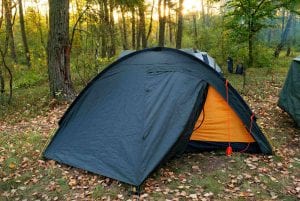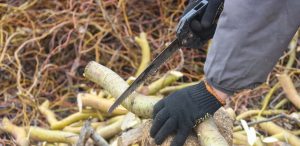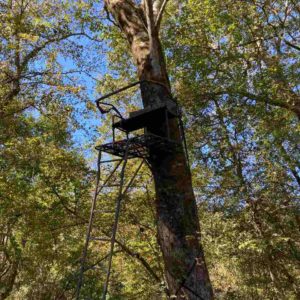Campfire time!
You’ll need a decent axe for that while you’re backpacking. Scratch that, you’ll want the best backpacking axe you can find.
But how are you supposed to choose between so many options? You want something light and small enough to carry easily. At the same time, it needs to pack enough of a punch to do the job you need it to do (whether that’s limbing, splitting or chopping kindling). My top pick for this is the Browning 231 Outdoorsman Axe — it ticks all those boxes.
Editor’s Spotlight
Looking for a backpacking hatchet that has some design flair as well as being extremely effective? You may be interested in checking out this beautiful Field Hatchet from Barebones Living…
It only weighs 1.2lbs. It’s blade is made from blackened steel and it also has a 1″ x 1.25″ hammer on the rear. At $65 it’s competitively priced compared to many higher-end axes and last time we checked their site was offering 15% off all orders. Take a look for yourself…
If you’re still lost in the woods, don’t worry. Here’s a breakdown of the best axes and hatchets for camping and backpacking. The list includes:
- Browning Outdoorsman Axe (best axe for backpacking)
- Hults Bruk Jonaker Hatchet (awesome backpacking hatchet)
- SOG Camp Axe (a solid lightweight backpacking axe)
- Fiskars Hatchet (a great value backpacking hatchet)
- Estwing Camper’s Axe (an excellent, slightly larger backpacking axe)
Browning Outdoorsman Axe Review – Best Backpacking Axe


Specs
This backpacking axe is 24″ long and weighs in at around 2.5lbs. The 1055 carbon tool steel axe head is flattened on the rear side. The handle is made of reinforced contoured polypropylene. It includes a nylon belt sheath.
The Verdict
This is a lightweight axe with a thin, razor sharp head and quick a flexible, shock-absorbing handle. It’s these features that make it a really good choice for backpacking where you don’t want too much weight in your pack and you’re unlikely to be doing any heavy felling.
It’s important to note that these same features do come with disadvantages too, though. For example, the thin head bites deep. And the flex in the handle means it absorbs some of the energy. Both of which adds up to a hatchet that is not great at splitting. Indeed, a few folks seem to had problems with this axe when doing heavy felling and splitting. (Basically, if you take a huge big swing into something really solid, you risk breaking the handle).
But if, like most backpackers and hunters, your intention is to have a moderate duty axe for light felling and limbing, chopping kindling and maybe even a bit of skinning or quartering then you’d be hard pressed to find a better tool.
The head is moulded on so you’re unlikely to separate it from the handle. The handle itself is completely impervious to the weather. It’s long enough to use two-handed and short/light enough to use one-handed making it perfect for bigger jobs as well as more delicate tasks. And the flattened rearside of the head is just the ticket for knocking in tent stakes.
In Summary
This is not a heavyweight axe for heavy felling. It’s a lightweight backpacking axe that can help you with a whole bunch of different tasks around camp. It won’t break you back carrying it about. It is super durable. And razor sharp. A very sold thumbs up!
Hults Bruk Jonaker Hatchet – Best Backpacking Hatchet

Specs
The Hulks Bruk Jonaker Hatchet weighs 1.5 pounds. Its 3-inch sharp edge is hand-forged out of Swedish steel. The 9.4-inch hickory handle is pre-treated with linseed oil. A leather sheath is included.
The Verdict
This is a really small backpacking hatchet but that’s what makes it a good choice if what you’re looking for is something to chop kindling, perhaps do some whittling or carving, lightweight camp chores, a bit of trail maintenance and even game prep.
Would you chop a tree down with it? No.
But its light weight and short handle make it ideal for more delicate tasks. Basically, it’s a great option if you enjoy carving or if you’re planning to hike longer trails or even if you’re in the market for a good survival hatchet..
It comes sharpened and ready to use straight out of the box, plus it’s designed to keep a sharp blade for many, many uses. The wooden handle is curved, which should provide adequate grip. There’s also a lanyard hole at the end. This could allow you to hang this hatchet from your belt or backpack — saving space inside for other essentials.
As I see it, this isn’t a mighty tool for felling big branches, but it is at home where creating kindling is concerned. Don’t expect much swinging leverage, but if you’re after a light, versatile field tool, it could be just the ticket.
In Summary
This small, lightweight number is probably one of the best hatchets you can buy full stop (not just one of the best backpacking hatchets). It is ideal for kindling and carving as well as light camp tasks and trail maintenance. It’s a great backpacking hatchet because of the balance between power and size.
If this one is not within budget, the Fiskars 378501-1002 X7 Hatchet may be another possibility. It’s small, works well for kindling cutting and has a lower price point.
SOG Camp Axe Review — Best Lightweight Backpacking Axe


Specs
The SOG Camp Axe weighs a mere 1.1 pounds and features a stainless steel head. It has a 3.1-inch blade and is 11.5 inches long. The handle is constructed from glass-reinforced nylon, like the accompanying blade sheath.
The Verdict
This is an axe to buy if practicality is important to you. It’s specifically advertised to be able to hammer in tent stakes as well as perform its chopping duties.
The SOG Camp Axe is another compact cutter — perfect for backpacking. It’s also the lightest one yet, which might suit those weight-watchers who like to trim every possible ounce from their packs. (The downside, of course, is that it may not have the best power to weight ratio for you).
The handle provides a sturdy grip, even close to the head. This could be particularly useful for when you need to make shavings to get your campfire going.
The sheath can be described as a molded cover — you slip it over the blade and loop the strap around the handle. However, one minor improvement would be if it came with a carrying option — at present, it would have to go in your backpack.
In Summary
This axe will give you a swift, balanced chop and it’s even smooth for throwing. If you’re just looking for something simple to carry with your pack, then it’s great for that too.
I chose this hatchet as the best ultra-light option not only because it’s the lightest, but for another reason. How light it is, coupled with the versatility put this into the category as the best ultra-light axe.
However, if you’re someone who needs to maximize on bag space, then an alternative could be the SOG Voodoo Hawk Mini. You may have to compromise on the weight aspect, yet the carry-case should give you more options for hanging it on the outside of your pack.
Fiskars Hatchet Review — Best Backpacking Hatchet


Specs
This Fiskars hatchet weighs in at 1.41 pounds. It has a forged steel head with a 3-inch blade and a Fibercomp® 14-inch handle. It also includes a hard plastic lockable cover.
The Verdict
Fiskars consider their axes to be unbreakable, which is always good news.
For those looking to attack small to medium-sized logs and kindling with minimal effort, this could appeal. I feel its power-to-swing ratio is spot on — it increases swing speed to multiply power like an aluminum baseball bat.
The blade has also undergone a special grinding technique to increase sharpness for cleaner cuts. Plus, the low-friction coating is designed to reduce the chance of the sharp end getting stuck.
It’s lightweight, portable and if you drop it in the undergrowth, its vivid orange color should make it relatively easy to spot.
The hard plastic sheath even includes a carry handle. However, one slight niggle is that should the locking mechanism break, it renders the whole cover unusable.
In Summary
I decided this was the best for chopping efficiency because of the power-to-swing ratio and the special techniques incorporated into the design by the manufacturer. I feel the blade is perfect for splitting wood into various different sizes — remember, you still have to put enough oomph into it.
Estwing Camper’s Axe Review — Best Camping Axe


Specs
The Estwing Camper’s Axe weighs in at 2.25 pounds and is 14.25 inches in overall length. The entire unit is made of fully-forged steel, tucked neatly into a rubber grip (for shock reduction). A nylon sheath is included to cover the 3.25-inch blade. It’s also available in three colors — black, orange and blue.
The Verdict
This axe is forged in one piece. It’s the only axe on the list that can boast this. If you’ve ever worried that your axe will separate during use, this one shouldn’t give you that thought.
I also appreciate that some of us, myself included, love to backpack with style. If you’re someone that finds matching up equipment important, the three different options should allow you scope for color coordination.
The grip is another neat feature. Having something to reduce the shock could make this safer for you. I’ve lost count of the number of times I’ve whacked a piece of wood and felt my bones ache afterward. The grip should lead to more time chopping, less time asking your doctor for a wrist brace or pain killer.
Additionally, the included sheath is made of heavy-duty material for your storing safety and convenience — taking the hassle out of buying extras.
This is an incredibly light axe, easy to cart around and use. It’s compact and nifty too, which should lower the chances of it getting in your way when not in use. I really like a smaller axe, they can be stowed away in a pack, hung on the belt without too much dangling and when at home — stored neatly in toolboxes.
If you’re struggling for space, then you could leave your mallet at home. In a pinch, you can use the back of the head as a hammer. Great for nailing down tent stakes.
In Summary
When it comes to camp chores, this hatchet should be a handy companion. The functions of this axe go beyond that of splitting wood — which could appeal to those looking for a camp axe that has real versatility— a wonderful little backpacking hatchet.
If you’re in the market for an axe with a multipurpose but would prefer something with more of a traditional feel, I’d suggest the Snow & Nealley (SNOW11-BRK) Penobscot Bay Kindling Axe. The back of the blade could certainly nail down those tent stakes for you.
Cold Steel War Hawk Axe Review


Specs
The Cold Steel War Hawk Axe weighs 1.8 pounds and it’s 19 inches in length. The 3-inch thin blade is made from carbon steel and the handle is polypropylene. A patented Secure-Ex blade sheath is also included.
The Verdict
The Cold Steel War Hawk is a very tough looking, war-style axe. It’s quite reminiscent of a battle axe without the extremities.
Its spike offers a multi-purpose element — getting into cracks to split stubborn logs, plus you could even use it for climbing or self-defense or as a survival axe.
Also, if using Mother Nature to your benefit grabs your attention, you might want to consider this axe. The spike can also be used for scraping — allowing you to mark your way.
It’s not just the spike that’ll work to your advantage — the blade is just as strong. It should cut through logs like butter, making plenty of kindling to warm yourself up with. A great axe to use after your battle with the elements, eliminating the evening chill.
The handle isn’t the shortest of all the backpacking hatchets on this list. Yet, because it’s so lightweight, you may not find the length an issue. Furthermore, the manufacturer acknowledges that — any handle can and will break eventually — by offering convenient replacements with a reasonable price tag.
In Summary
This axe is light, sharp and affordable. It cuts firewood like a boss and could probably even tackle some thicker branches (though not small trees).
Yet, the additional touches this axe brings to the table gives this little hatchet a leg up into the best value. I view this axe with many positive factors that’ll serve you well when attached to your backpack.
If you still want to keep budget in mind, but you’d prefer an axe with that classic look, then the Marbles Outdoor Axe might be something to consider. It’s not the lightest on the list, but I believe it’s competitively priced.
Snow and Nealley Kindling Axe Review

Specs
The Snow and Neally weighs 2.4 pounds. The handle length totals 17 inches and the sharp cutting edge is 3 inches long. It has a drop forged steel head and a hickory handle. A leather sheath is also included.
The Verdict
It’s one of the heavier axes among the pack, giving it more bite, but making it more cumbersome for carrying around. The handle isn’t long enough to hold above your head and swoop—but you could cut 4-inch logs with enough power.
Like a couple of other axes in this list, using it as a makeshift mallet is a possibility. I feel the back of the head is sufficient for this, owing to it being flat and sturdy.
The wood handle has a great shape to it. A wood handle without grips or grooves can have a tendency to fly right out of your hand (especially is you have sweaty palms!). The smooth, elegant, curved shape of the handle means this one should stay put no matter how hard you swing.
It does arrive non-sharpened, which means you will have to sharpen it yourself. If you don’t know how to create a good cutting edge (or don’t want to learn) I recommend you look elsewhere!
In Summary
If you’re looking for an axe with some weight behind it, this may be the one to go for. It’s perfect for backpacking and great for making kindling. It’s bigger than a hatchet, smaller than a full-size axe. Highly suitable for someone looking for something in between.
This is such a strong, solidly built axe, it’s my best for heavy-duty, and it’s brilliant for budding lumberjacks. You should have no trouble chopping up potentially bigger chunks of wood. If you can swing hard enough, this axe should be able to handle it.

Marbles Outdoors Axe Review

Specs
The Marbles Outdoor Axe weighs in at 2.45 pounds. Its 3.5-inch blade is steel and the handle is made of Hickory wood, complete with a lanyard hole. The total length of the axe measures 20.25 inches. You also have the option to purchase with or without a leather sheath.
The Verdict
This is a good axe if you’re on a budget. It’s light, so it’s easy to swing and carry around with you even after a long day of woodland walking.
At 20.25 inches, it’s longer than what you’d class as a typical backpacker size. However, the tradeoff is that it could be nifty for those bigger log cutting jobs. This also allows space for the use of both hands, which should give you more power behind the strike.
I feel the attention to detail has gone into the crafted Hickory wood handle. This could be ideal for those who want an axe sporting a traditional design.
Furthermore, the lanyard hole gives you the option to hang it up when not in use. Alternatively, you could hang the axe out of your backpack to save space inside.
In Summary
I believe this is a fantastic axe for making light work of larger pieces of wood for that roaring campfire — hence my best for full-sized logs award. However, it’s not the lightest, so if you regularly trek deep into the trails, it may not be the most practical option.
If the classic style appeals, yet you prefer a more compact handle, the Hults Bruk Jonaker Hatchet could be an option — but it does come with a higher price tag.

SOG Voodoo Hawk Mini Review


Specs
The Voodoo Mini weighs 1.44 pounds. It has a 2.75-inch steel head and a 12.5-inch glass-reinforced nylon handle. This also includes a ballistic nylon sheath with a belt loop.
The Verdict
I have to say, this for me is, truly, a survivor’s axe. Hacking up kindling, stray branches and possibly even helping you climb with that spike. I love its sleek and modern design, plus the sturdy construction is evident.
This axe can also be used as throwing hatchet or the pommel turns it into a hammer — adding versatility into the mix.
The beard of this axe drops low, providing a larger blade for cutting and throwing, plus the pommel adds some balance to it. These are excellent features if you like a small axe that can cover a lot with a single swing.
I find splitting wood with some heavier axes akin to a heavy workout — within five minutes I can feel the burn in my arms. The durable handle is lightweight, which should make campfire duties seem less of a chore. It’s also easy to grip with grooves for your fingers — keeping you in control and mishaps at bay.
The sheath is more like a carry-case, so when it’s tucked away, grab a carabiner and attach it to your backpack or through your belt loops. This is the only axe in the lineup with this convenient feature.
In Summary
If you’re looking for a utility tool that is multi-use and doesn’t take up much space — this one could be just the ticket. I feel it’s well equipped to handle all aspects of outdoor life — backpacking, camping, hunting and garden maintenance.
Why Use a Backpacking Axe?
There are two simple answers: for camp firewood and for clearing your way.
For chopping fallen trees and breaking up huge logs, you’ll want a backpacking hatchet less suited to carrying around with you. So stay small for splitting and kindling and hacking down thorny bushes that threaten your path.
Here are a few more creative uses for a small camping axe:
If you’re backpacking off-trail, without a map or compass, you could also use an axe to mark your way. Leaving an “X” on a tree will indicate where you’ve been like a breadcrumb trail.
Lastly, if you encounter a wild animal, you know can’t climb, your axe can help you to safety. If it’s strong and you can get it in deep enough, using it to pull yourself up a tree could potentially remove you out of harm’s way.
Axe vs. Hatchet — What’s the Difference?
Although they look very similar, there is one key distinction — the handle length.
An axe is typically designed for two-hand use. It’s longer and most of the work is done by the weight of the axe head. In contrast, a hatchet has a shorter handle and is designed for one-handed operation. This does mean a bit more effort on your behalf.
There are a few other types of axes in this list you might like to know more about. Let’s break those down.
Battle Axe
A battle axe is small and designed to be held in one hand. They’re extremely tough and designed to carry power with their swing. This could be great for people looking to tackle bigger logs while looking like a Viking, but the truth is they tend not to be very practical as a backpacking hatchet.
Tactical Axe
Tactical axes are said to be jacks of all trades and are popular with campers. This type is usually made of forged steel or carbon steel and designed in a way to help with specific tasks. Some have a cutting edge specifically engineered for climbing or hammering.
A quality tactical axe should be immensely strong and useful to anyone out in the wilderness.
Tomahawk
Although Tomahawk axes are often classed as tactical, they’re also a category of their own. These axes have different axe blades from more standard backpacking hatchets and are often used on camping trips by preppers. They can be used to chop wood and clear brush.
Some, like a throwing axe (for example the SOG Tomahawk Throwing Axe) are often better used as a weapon which rather than an all-purpose survival axe. Again, that means if you are looking for a dedicated backpacking hatchet you’d be better looking for something that is specifically designed to be a backpacking hatchet (in other words not a tactical tomahawk). But if you want a wildlife hatchet / weapon hybrid, this can be a good style to buy.
Survival Axe
This probably isn’t a distinct style but it’s probably worth mentioning that a survival hatchet is likely to be a very compact hatchet. Survival gear is usually prioritising weight over functionality (in that you’d rather have one small, light tool that performs many functions to an acceptable standard). So the best survival hatchet is likely to something like the Cold Steel War Hawk because it can split as well as chop wood.
How to Choose the Best Backpacking Axe
Here are a few pointers worth considering when looking for the best backpacking hatchet:
- Handle Length
- Weight
- Hatchet Head
- Aesthetics
- Multifunctional
Handle Length
They say size doesn’t matter — it’s how you use it. Put this to the back of your mind when choosing the best backpacking hatchet. The length of the handle does make a difference.
Longer handles will produce a greater swing speed, which means cutting wood will take less effort. Consequently, this equates to an axe that takes up more valuable backpacking space.
Short handles are lighter, easier to carry, just don’t anticipate chopping logs or small trees (think more of kindling and big branches).
The best backpacking hatchets are between 10″ and 24″. Less than 10″ might lack the power you want. Meanwhile a 24″ handle doesn’t make for the most compact hatchet.
Weight
When backpacking, both weight and space are at a premium. For base camping or kayak camping you can definitely spring for a bigger, heavier camping hatchet. But when covering long distances you want to avoid carrying excess baggage. So the best backpacking hatchet will be a lightweight axe that is also compact.
Most backpacking hatchets weigh between 1lb and 3lbs. The compromise you have to make is the power to weight ratio; between carrying extra weight and easily splitting firewood. (Lighter backpacking hatchets are obviously easier to carry but they mean that that you may to put in more effort when splitting firewood).
Aesthetics
When choosing a camping axe, practicality should always be your main priority. However, who’s to say it can’t look smart too?
Yet, there are also times when attention to detail doubles as functional. Bold colors on a handle will make it easier to track down if you forget where you placed it. Some people like a hickory handle. Others prefer a rubberized handle. Some even like a lacquered leather grip…
Multifunctional
Some of the best backpacking axes serve more than one purpose. That is, they go beyond chopping logs. You’ll find a hammer head handy for tapping in tent pegs or a spiked end for throwing, puncturing cans of food and a pick for digging.
Think about whether any of these uses will be of use to you when you’re in the wild.
Safety Precautions
Always ensure you have a sheath for your backpacking hatchet. In terms of safety, this is non-negotiable because you really don’t want an exposed blade. An axe blade can easily injure you or much worse and if you’re backpacking alone even more so.
Whenever you’re carrying an axe, also ensure you have a first aid kit handy. Even if you’re just testing the blade, it’s easy to cut yourself. In the wilderness, even a minor unbandaged wound can put you at risk for a number of infections.
It’s sensible to practice with your new axe at home before taking it to the great outdoors. Your backyard will give you a chance to explore any challenges the new tool brings.
Make your mistakes when you’re somewhere safe with people around. That way, what would’ve been a disaster in the woods is just a whoops in the yard.
Conclusion
For me, the best overall camping axe has to be the SOG Voodoo Hawk Mini. It’s solidly made, the sheath is incredible and it’s so versatile. It’s not too heavy, easy to grip and durable. My runner up is the Estwing Camper’s Axe — I just love that one-piece forge, and it’s got a sturdy grip.
If you want a survival hatchet, then consider the Cold Steel War Hawk on account of it’s dual splitting:chopping capability. Although, for pure size and weight, the SOG Camp Axe could actually be the best survival hatchet.
As you make your decision, be sure to consider everything — weight, functionality, handle, axe head and any included add-ons for extra safety or practicalities. My top choices should appeal to most people, but at the end of the day, it’s what’s right for you. Hopefully, at least one of these fantastic suggestions has ticked all your boxes.
FAQs
What Size Axe Do You Need for Backpacking?
The best size axe you need for backpacking depends largely on what you need your axe for and how much extra weight you are willing to carry. Generally speaking though, look for axes that have a handle between 10″ and 24″ and that weigh between 1lbs and 3lbs.





